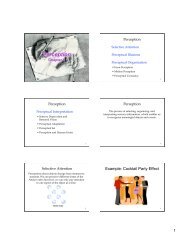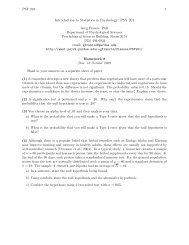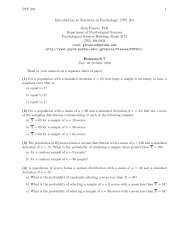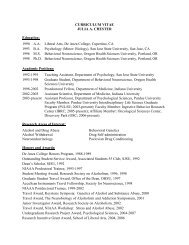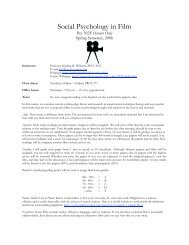Psyc 120 Exam 2 Study Guide
Psyc 120 Exam 2 Study Guide
Psyc 120 Exam 2 Study Guide
You also want an ePaper? Increase the reach of your titles
YUMPU automatically turns print PDFs into web optimized ePapers that Google loves.
<strong>Exam</strong> 2 <strong>Study</strong> <strong>Guide</strong><br />
Elementary <strong>Psyc</strong>hology <strong>120</strong>00-003<br />
Ch 4: Nature, Nurture, and Human Diversity<br />
• Know what chromosomes, genes, DNA, and genomes are, and how they are interrelated.<br />
• Explain what behavioral genetics and molecular genetics refer to and what questions they<br />
help us understand.<br />
• Explain the difference between gender and biological sex.<br />
• What are the main tenets of evolutionary psychology?<br />
• Know gender similarities and differences in aggression, social power, and social<br />
connectedness.<br />
• How do twin studies and adoption studies inform research on the relative effects of genes<br />
versus the environment on human behavior?<br />
o What are the main findings of twin studies and adoption studies?<br />
• What is a gene-environment interaction?<br />
• What do natural selection and artificial selection refer to?<br />
• Know the roles that the prenatal environment, parenting, one’s peer group, and culture<br />
play in shaping human development.<br />
• What is heritability?<br />
Ch. 5: Developing Through the Life Span<br />
• Identify and describe the big three issues that developmental psychologists study (e.g.,<br />
continuity/stages etc)<br />
• What types of research methods do investigators use to assess cognitive ability in infants?<br />
(e.g., habituation)<br />
• Explain the physical development of humans, including brain development, motor<br />
development, hormonal changes, maturation, and memory.<br />
• Understand the difference between assimilation and accommodation.<br />
• What distinguishes between secure and insecure attachment styles? How are attachment<br />
styles investigated with infants? What is the significance of Harlow’s monkey studies?<br />
• What are the stage theories of Piaget, Erickson, Kohlberg, and Freud?<br />
• How do parents, daycare, and peers influence our identity formation?<br />
Ch. 6: Sensation and Perception<br />
• What is the point of the “dark restaurant story” that Dr. Williams told?<br />
• What is the difference between top-down and bottom-up processing? How does memory or<br />
expectations influence processing?<br />
• How is sensation different from perception?<br />
• Distinguish between absolute, subliminal, and difference thresholds<br />
• What’s a jnd (just noticeable difference)?<br />
• What is Weber’s law?<br />
• What is visual prosopagnosia and how does it relate to sensation and perception?<br />
• Define parallel processing and discuss its role in visual information processing.<br />
• What are the basic differences between the trichromatic theory and the opponent-process<br />
theory?<br />
• Be able to identify the basic parts and functions of eyes and ears.
• What is the purpose of pain and what is the gate-control theory?<br />
• What did research on chili peppers and supertasters tell us about pain therapy (video)?<br />
• How is smell related to memory?<br />
• Describe the relationship between Gestalt psychology and perception.<br />
• Know the following Gestalt principles: similarity, proximity, continuity, closure, area,<br />
figure versus ground, and symmetry.<br />
• What is depth perception and describe the visual cliff research.<br />
• How do we perceive motion? What is the phi phenomenon?<br />
• Explain the importance of perceptual constancy and perceptual adaptation.<br />
• How has sensory deprivation and restored vision research helped our understanding of the<br />
nature-nurture debate?


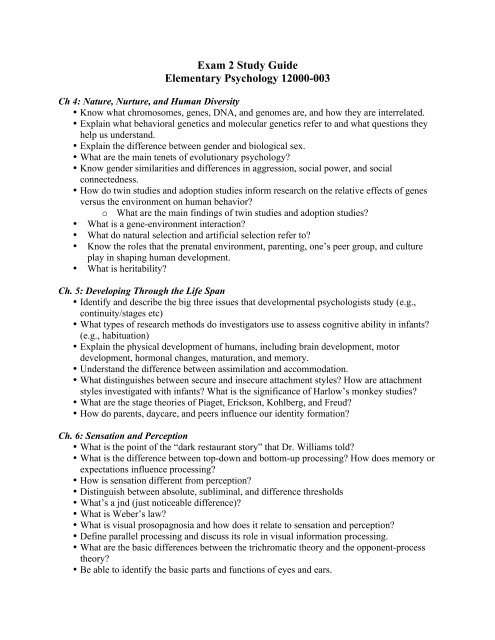
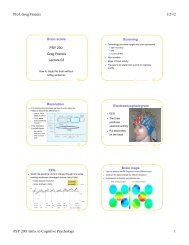

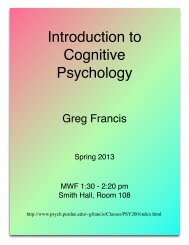
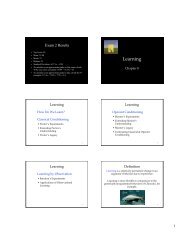
![Exam 4 Study Guide[1]](https://img.yumpu.com/45196739/1/190x245/exam-4-study-guide1.jpg?quality=85)
